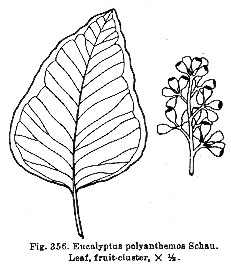Eucalyptus polyanthemos
 red box
red box
One of the popular choices on campus, having florist-quality, silver-blue, easily collected foliage. The flower-bud panicles, formed of dozens of silvery pillules can also be picked in great bunches. Almost circular juvenile leaves, 2 inches or more in diameter understandably have given currency to the name silver dollar gum. As with other common names, this one is not very useful for distinguishing from the other quite different gums commonly referred to by the same name. The trade name red box refers to the color of the heartwood and to the finely matted bark texture. As the tree grows, the juvenile leaves give over to mature lanceolate (noncircular) leaves that are quite different in appearance, though still often colored blue by the fine waxy coating that cold-climate eucalypts often secrete for protection.
An imposing specimen opposite 69–70 Pearce Mitchell Place, which flowers in late winter, has no silver dollars at all. Many specimens can be seen on both sides of Campus Drive East between Serra Street and Escondido Road; tall trees dating back to the Pine Hill residential development line the north side of Estudillo Road. A double-trunked specimen, possibly our largest, grows at Rains Houses building 208, on the east side of the complex next to the wisteria-covered pergola.

Illustrations: gallery.
Related material: Stanford Grounds Plant Information Sheet, List No. 6, Page 9.
About this Entry: The main text of this entry is from the book Trees of Stanford and Environs, by Ronald Bracewell, published 2005.




